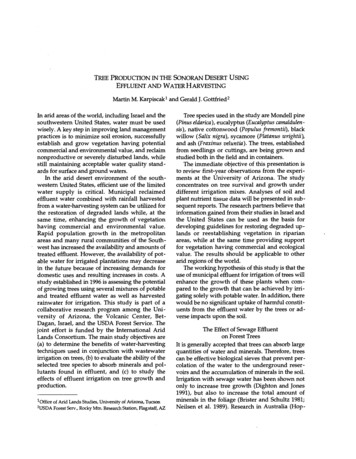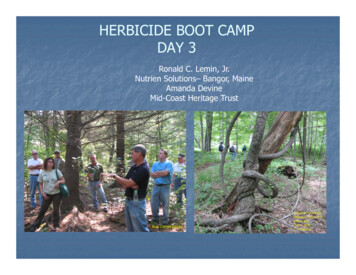
Transcription
TREE PRODUCTION IN THE SONORAN DESERT USINGEFFLUENT AND WATER HARVESTINGMartin M. Karpiscaki and Gerald J. GottfriedeIn arid areas of the world, including Israel and thesouthwestern United States, water must be usedwisely. A key step in improving land managementpractices is to minimize soil erosion, successfullyestablish and grow vegetation having potentialcommercial and environmental value, and reclaimnonproductive or severely disturbed lands, whilestill maintaining acceptable water quality standards for surface and ground waters.In the arid desert environment of the southwestern United States, efficient use of the limitedwater supply is critical. Municipal reclaimedeffluent water combined with rainfall harvestedfrom a water -harvesting system can be utilized forthe restoration of degraded lands while, at thesame time, enhancing the growth of vegetationhaving commercial and environmental value.Rapid population growth in the metropolitanareas and many rural communities of the Southwest has increased the availability and amounts oftreated effluent. However, the availability of potable water for irrigated plantations may decreaseTree species used in the study are Mondell pine(Pinus eldarica), eucalyptus (Eucalyptus camaldulen-sis), native cottonwood (Populus fremontii), blackwillow (Salix nigra), sycamore (Platanus wrightii),and ash (Fraxinus veluntia). The trees, establishedfrom seedlings or cuttings, are being grown andstudied both in the field and in containers.The immediate objective of this presentation isto review first -year observations from the experi-ments at the University of Arizona. The studyconcentrates on tree survival and growth underdifferent irrigation mixes. Analyses of soil andplant nutrient tissue data will be presented in subsequent reports. The research partners believe thatinformation gained from their studies in Israel andthe United States can be used as the basis fordeveloping guidelines for restoring degraded up-lands or reestablishing vegetation in riparianareas, while at the same time providing supportfor vegetation having commercial and ecologicalvalue. The results should be applicable to otherin the future because of increasing demands fordomestic uses and resulting increases in costs. Aarid regions of the world.The working hypothesis of this study is that theuse of municipal effluent for irrigation of trees willstudy established in 1996 is assessing the potentialof growing trees using several mixtures of potableenhance the growth of these plants when compared to the growth that can be achieved by irri-and treated effluent water as well as harvestedrainwater for irrigation. This study is part of acollaborative research program among the University of Arizona, the Volcanic Center, Bet -gating solely with potable water. In addition, therewould be no significant uptake of harmful constit-uents from the effluent water by the trees or adverse impacts upon the soil.Dagan, Israel, and the USDA Forest Service. Thejoint effort is funded by the International AridLands Consortium. The main study objectives are(a) to determine the benefits of water -harvestingtechniques used in conjunction with wastewaterirrigation on trees, (b) to evaluate the ability of theselected tree species to absorb minerals and pol-lutants found in effluent, and (c) to study theeffects of effluent irrigation on tree growth andproduction.The Effect of Sewage Effluenton Forest TreesIt is generally accepted that trees can absorb largequantities of water and minerals. Therefore, treescan be effective biological sieves that prevent per-colation of the water to the underground reservoirs and the accumulation of minerals in the soil.Irrigation with sewage water has been shown notonly to increase tree growth (Dighton and Jones1991), but also to increase the total amount of1Office of Arid Lands Studies, University of Arizona, Tucson2USDA Forest Serv., Rocky Mtn. Research Station, Flagstaff, AZminerals in the foliage (Brister and Schultz 1981;Neilsen et al. 1989). Research in Australia (Hop-
Karpiscak and Gottfried38mans et al. 1990) indicates that tree species differlock and Dutt 1986; Matlock 1983; Dutt et al. 1981).widely in their ability to absorb minerals. Thedifferential accumulation of toxic elements byUsing effluent as a source of supplementalwater for creating and enhancing wetlands andfreshwater plants has been reviewed recently in ariparian areas in Arizona and throughout thecomprehensive report by Outridge and Nollerentire southwestern United States is proving to be(1991). Information on the accumulation of toxiccompounds by tree species exposed to effluent islimited. A major factor that needs to be consideredwhen trees are used to dispose of effluent is thevariation among species.an important management technique (Tellman1992). The creation of additional wetlands andriparian areas is important because in the south-Secondary sewage effluent generated fromdomestic use contains mainly organic matter andminerals. Organic matter often accumulates undereffluent irrigation, and organic nitrogen has beenfound to increase under a wide range of climatic,water, and soil conditions (Brar et al. 1978; Feiginet al. 1978). Organic C and organic N increasedfour- to five -fold in the upper 3 inches of the soillayer (Brar et al. 1978). Feigin and coworkers(1978) calculated that approximately 7 percent ofthe amount of nitrogen applied remained in thesoil. The buildup of organic matter contributeseventually to all of the elemental cycles in the soil.Organic matter content and composition, togetherwith the environmental conditions, determine therate of nutrient uptake by plants.Eucalyptus camaldulensis , introduced into Israelmany years ago, has proven to be a fast -growingtree species. Eucalyptus has the capacity of absorbing large quantities of water and minerals.Mature eucalyptus trees can evaporate up to 15gallons of water per day (Walker et al. 1991). It ishypothesized that irrigating with sewage water inthe proper quantities might compensate for theloss of water through evaporation, and also stimulate tree growth. Eucalyptus has a very branchedroot system that is active all year, contributing tothe efficiency of this species. A two -fold increasein tree growth following irrigation with sewagewater compared to control trees has been recordedfor woody species such as Populus (Bialkirwicz1978), Pinus (Cromer et al. 1983; Attiwill andCromer 1982), Eucalyptus, and Casuarina (Stewartand Flinn 1984).Water Harvesting and EffluentAs a Supplemental SourceIncreasing competition for water in arid and semi-arid regions has stimulated interest in a widerange of techniques for increasing water availability. Researchers at the University of Arizona haveactively explored the use of water -harvestingtechniques for agriculture in the and and semiaridregions (Karpiscak et al. 1987; Matlock 1986; Mat-western United States, riparian areas occupy onlyabout 1 percent of the land surface. However,these areas are valuable for many reasons. Theissue of effluent use in the major metropolitanareas of Phoenix and Tucson was discussed in apaper by Lieuwen (1990). Interest in the UnitedStates in treating municipal wastewater usingplant systems has increased as an ecologically andeconomically viable alternative to traditional treatment methods (Hammer 1989; Reed et al. 1995;Karpiscak et al. 1996; Kadlec and Knight 1996).Riparian Area Management in theSouthwestern United StatesMore than 800 vertebrate species, many (250 )threatened, endangered, and sensitive, reside inthe Southwestern Region of the USDA ForestService. A majority of these animals are eitherobligate inhabitants of riparian areas or utilizethem at some stage of their life cycle. Because ofthe cool environment provided by these riparianareas, they attract many recreationists. They alsoare important areas for livestock watering andlocal water supplies. However, the past misuse ofriparian areas throughout the southwesternUnited States has resulted in vegetation destruc-tion, both in the riparian areas and in the surrounding watershed (DeBano and Schmidt 1989).Vegetation removal and soil compaction on thewatersheds have increased surface runoff fromthese areas and concentrated the resulting streamflow in channels where it has caused down cutting and subsequent dewatering of the riparianareas, thereby upsetting the hydrologic regimesnecessary to sustain many of these former riparianareas. Implementing methods of rehabilitating andenhancing these degraded riparian areas in partnership with private and public land owners is animportant goal for USDA Forest Service managers(Tellman et al. 1992). Reversing such degradationwill require establishing a regulated streamflow.Both effluent additions and water- harvestingtechniques provide opportunities for developingthe more regulated streamflow regimes necessaryfor rehabilitating many of these degraded riparianecosystems.
Tree Production Using Effluent and Water HarvestingMethodsThe sites in Arizona include a field plot at a University of Arizona research farm near Tucson, andan area for the container experiments at the nearbyConstructed Ecosystems Research Facility (CERF),supported by the Pima County Wastewater Man-agement Department. The field plot consists ofabout 1.3 hectares (3.2 acres) that can be irrigatedwith both potable and reclaimed water as well asharvested natural rainfall. After receiving permission to proceed at the research farm, 15- foot -widecatchments were graded perpendicular to theslope of the field.The field and container experiments in Arizonainclude six tree species: cottonwood, black willow,Mondell pine, sycamore, velvet ash, and eucalyptus. Cottonwood, black willow, sycamore, and ashare important southwestern riparian tree species,and Mondell pine and eucalyptus are popularornamental species in the metropolitan areas ofArizona. The eucalyptus species is being used inthe experiments in Israel. Trees for the field andcontainer studies were started from poles exceptfor Mondell pine and eucalyptus. These specieswere planted as transplants from plastic sleevesand 4 inch pots, respectively. Ash and sycamorewere replanted because of poor survival after theinitial planting. The field experiments focus onfive treatments that reflect a range of watermixtures:1. Control only, with water from harvestedrainfall and potable municipal water equal to 100percent of pan evaporation.2. Irrigation to 100 percent of pan evaporationwith 25 percent of water being reclaimed municipal effluent.3. Irrigation to 100 percent of pan evaporationwith 50 percent of water being reclaimed municipal effluent.4. Irrigation to 100 percent of pan evaporationwith 75 percent of water being reclaimed municipal effluent.5. Irrigation to 100 percent of pan evaporationwith 100 percent of water being reclaimed municipal effluent.Separate drip irrigation supply lines for potableand reclaimed water are equipped with separatetimers to ensure that the proper amount of irriga tion water, either potable or reclaimed, is suppliedto the individual plants. Supplemental irrigation isprovided by a drip system.Fifty individuals each of six tree species wereplanted in a randomized complete block design inthe water- harvesting field system. Ash and syca-39more were planted as poles obtained from trees atFort Huachuca, Arizona. Black willow and cottonwood were planted from cuttings collected fromtrees at the nearby CERF facility, and eucalyptusand pine were purchased commercially. Plantingof all species in the field was completed in December 1996. Height measurements of pine and eucalyptus were begun in December 1996 and of theother four species in May 1997. Tree diameter atbreast height (DBH) measurements were started inSeptember 1997.The individual trees in the field plots werefenced to protect them from rodents and rabbitsuntil they had achieved enough growth and size tosurvive browsing by animals. The field plots areperiodically treated to control weeds.Soil samples were collected from the field plotsprior to planting in 1996 and again in December1997. The first tissue samples will be collectedfrom the field plants in late spring 1998 after theyhave achieved sufficient size to sustain the harvesting of 100 to 125 grams of leaf and stem tissue.The tissue will be analyzed for selected parameterssuch as sodium, chloride, phosphate, nitrate, andcopper.Containers are used to avoid the influence ofdifferences in field soils using the same tree species as those planted in the field water -harvestingsystem. The container studies are conducted using10 replicates of each plant species. These experiments were started at CERF in April 1997 by filling120 plastic 32- gallon containers with clean mortarsand. Two drip lines were installed to each of thecontainers, one to deliver potable water and one todeliver treated effluent. Each container is suppliedwith either 100 percent potable water or 100 per-cent effluent water. A chlorinization unit wasplaced in the effluent line so that all plants wouldreceive water containing chlorine. Trees and emitters were placed randomly in the containers. Pineand eucalyptus were planted as seedlings in May1997 and cottonwood and black willow as poles inJune 1997. The remaining two species, ash andsycamore, were planted as poles in August 1997.Data are logged into an IBM computer usingQuattro Pro software to create a spreadsheet. Because field and pot experiments are conducted in arandomized complete block design, any of thevariables that are measured only once during theexperiment will be subjected to an analysis of variance for the randomized complete block design.Any trends in the characteristics over time will beestimated for each of the treatments. If the characteristics change over time, then the differences in
Karpiscak and Gottfried40trends among the treatments will be tested forstatistical significance. The 5 percent level will beused to determine significance unless otherwisestated. However, as this is a preliminary report ontree survival and initial growth, no statistical analysis will be discussed at this time because of theshort growing time since planting.Survival data for the container trees are shownin Figure 2. Note that no cottonwood pole plantssurvived the initial June transplanting to the containers, in contrast to the nearly 100 percent survival obtained in the field planting. This finding alsois in contrast to the survival of similar transplantsin the gravel- filled subsurface constructed wetlandcells at CERF. Cottonwood poles were replanted inResults and DiscussionTree survival at the field site is shown in Figure 1.Note the nearly 100 percent survival rate for euca-containers in early November 1997, and thus nodata were available on their survival in Novemberlyptus and pine, planted as transplants, and forcottonwood and willow, which were planted assurvival of some ash and sycamore plants in De-pole cuttings, regardless of the water mixture. Ashand sycamore, also planted from pole cuttings,had about an 80 percent survival rate. Initial survi-val was lowest for sycamore (20 percent) whentreated with pure effluent (OP /4E), and ash (60percent) when treated with one -quarter effluent(3P /1E). These rates for ash and sycamore are improved from the 30 and 50 percent rates observedpreviously (August 1997). It appears that poleplants of these two species are slower to take rootand show a growth response compared to willowand cottonwood.or December 1997. It was difficult to determine thecember, because they were typically small individ uals that had dropped their leaves.Plant survival in the field appeared to be thesame for willow and cottonwood (poles) and foreucalyptus and pines (transplants) whether irri-gated with 100 percent potable or 100 percenteffluent water (Figure 3). Survival for sycamoreand ash (poles), however, appeared to be lowerwhen irrigated with effluent water in the field.This observation seemed to be the case particularlyfor sycamore, whose survival rate decreased overtime (Figure 3) when compared to surviving sycamore irrigated with only potable water.Tree Survival by Species and TreatmentNovember 1996 -December 1997IALC Field Plots10oBlack WillowCottonwoodtreatment: P potable E effluentOP/4EA 1 P/3E2P2EEucalyptusPineAshtree species3P/1E 4P/OEFigure 1. Tree survival by species and treatment.Sycamore
Tree Survival in ContainersUsing Potable WaterJuly 1997 - December 199710864 ---20Sep97Aug97Jul97Nov97Dec97sample monthtree speciesBIkWiIPineEucalCtnwdAsh . SycmrTree Survival in ContainersUsing Effluent WaterJuly 1997 - December 199710864204Jul97Aug97Sep97Nov97Dec97sample monthtree speciesBlkWil 4 CtnwdEucal1 PineAsh . SycmrFigure 2. Tree survival in containers using potable and effluent water.
Tree Survival in Field Plotsfor Treatment A - All Potable WaterDecember 1996 -December 1997108o0a64Ec2oDec96Mar97Apr97May97Jun 97Jul97Sep97Nov97Dec97sample monthtree speciesBIkWiI /A CtnwdAsh - SycmrPineEucalTree Survival in Field Plotsfor Treatment E - All Effluent WaterDecember 1996 -December 19971086%ÿV%íVi42oDec96Mar97Apr97tree speciesBlkWil CtnwdEucal\May97Jun 97Jul97Sep97Nov97Dec97sample monthPine] Ash . SycmrFigure 3. Tree survival in field plots using potable and effluent water.
Average Tree Height by Species and LocationIrrigated with Potable WaterIn December 1997Black WillowCottonwoodEucalyptusPineAshSycamoretree speciesnt no tree apparently survivingfield plots '4 containersAverage Tree Height by Species and LocationIrrigated with Effluent WaterIn December 1997Black WillowCottonwoodEuca yptusPineAshSycamoretree speciesfield plots r4 containersnt no tree apparently survivingFigure 4. Average tree height by species and location irrigated with potable and effluent water.
44Karpiscak and GottfriedCottonwood and black willow have shown4). Black willow irrigated with effluent grewrapid growth in the field plots. Many of the cottonwood trees were almost 8 feet high by December1997 (Figure 4). Pine initially responded very wellneed to keep the sand moist during the initialslightly taller in the field (Figure 4). Eucalyptusappears to have the best growth in the containers,after the effluent -irrigated willow, and seemsequal to the effluent -irrigation black willow (Figure 4). These results indicate the potential for theuse of effluent for growing selected tree crops forwood production, aesthetics, and environmentaltransplanting of pole plants in other containers onbenefits.in both field and container plantings (Figure 4).However, many of the transplants to the containers have shown stress, most likely because of thethe same drip irrigation line. Black willow hasshown rapid growth in both the containers and thefield (Figure 4). Ash and sycamore are showingslower growth in the containers, as well as in thefield plots as noted above.Eucalyptus has shown growth in the containerexperiments and the field plots. Although this species seems to grow in both the clay soil of the fieldplots and the sand of the container experiments, itappears to be responding much better to the sandculture found in the containers (Figure 4). How-Selected ReferencesAttiwill, P. M. C. and R. N. Cromer. 1982. Photosynthe-ever, some of the plants in the field plots haveshown rapid growth in height (Figure 4). Thisfinding supports the results found by our Israeliwater. J. Water Pollut. Control Fed. 58: 708 -719.Brister, G. H. and R. V. Schultz. 1981. The response of asouthern Appalachian forest to waste water irrigation.team members. One of the most interesting issueswas the failure of any of the cottonwood and sycamore pole plants (some 60 cuttings of each species)to become established in the containers. Theseplants were replaced with new poles.Preliminary ConclusionsThe application of supplemental irrigation waterto trees in arid environments can achieve rapidestablishment and growth of some tree speciessuch as cottonwood and willow. Field tree survival rates were 90 to 100 percent for most speciessis and transpiration of Pinus radiata D. under planta-tion conditions in southern Australia in response toirrigation with waste water. Aus. J. Plant Physio. 9:749 -760.Bialkirwicz, F. 1978. Some aspects of the purificationand utilization of municipal sewage in forest plantation. Sylvan 122: 7 -17.Brar, S. S., R. H. Miller and T. J. Logan. 1978. Factorsaffecting denitrification in soils irrigated with wasteJ. Environ. Qual. 10: 148 -153.Cromer, R. N., D. Tompkins and N. J. Barr. 1983. Irrigation of Pinus radiata with waste water, tree growth inresponse to treatment. Aust. For. Res. 13: 57-85.DeBano, L. F. and L. J. Schmidt. 1989. Improving south-western riparian areas through watershed management. USDA Forest Service General Technical ReportRM -182. Rocky Mountain Forest and Range Experiment Station, Ft. Collins, Colorado.Dighton, J. and H. E. Jones. 1991. The use of roots to testN, P, and K deficiencies in Eucalyptus nutrition.IUFRO Symposium on Intensive Forestry: The Role ofEucalyptus. Durban, South Africa, pp. 635 -643.(Figure 3). Initial survival rates for container-Dutt, G. R., C. F. Hutchinson and M. Anaya Gardunogrown trees varied from the field rates. The use ofeffluent may be beneficial because of the nutrientsfound in the wastewater. However, this prelimi-and semiarid regions. Proceedings of a workshophosted by the University of Arizona, USA and thenary observation still needs to be statisticallyevaluated. Sycamore pole -plants appear to have ahigher rate of survival in field plots when suppliedwith potable water, whereas ash appears to dosomewhat better over time in the field with efflu-ent. Almost all other species appeared to haveabout the same rate of survival in the field whensupplied with either potable or effluent water.Overall average growth appears best in cottonwood and willow grown in the field.First -year results have shown that some species,especially cottonwood and willow in the field,grew to a height of 6-8 feet within 12 months ofplanting (Figure 4). Pine and black willow hadtheir most rapid growth in the field plots (Figure(Eds.). 1981. Rainfall collection for agriculture in aridChapingo Postgraduate College, Mexico. Commonwealth Agricultural Bureau. Slough, United Kingdom.Feigin, A., H. Bielorai, Y. Dag, T. Kipnis, and M. Giskin.1978. The nitrogen factor in the management ofeffluent -irrigated soils. Soil Sci. 125: 248 -254.Feigin, A., I. Ravina and J. Shalhevet. 1990. Irrigationwith treated sewage effluent. Springer Verlag, Berlin.Hammer, D. A. 1989. Constructed wetlands for wastewater treatment: Municipal, industrial and agricultural. Lewis Publishers, Chelsea, Michigan.Hopmans, P. J., T. L. Stewart, D. W. Flinn, and T. J. Hill-man. 1990. Growth, biomass production and nutrientaccumulation by seven tree species irrigated withmunicipal effluent at Wodonga, Australia. For. Eco.Man. 30: 203 -211.Kadlec, R. H. and R. L. Knight. 1996. Treatment wetlands. CRC Lewis, New York.
Tree Production Using Effluent and Water HarvestingKarpiscak, M. M., C. P. Gerba, P. M. Watt, K. E. Foster,and J. A. Falabi. 1996. Multi- species plant systems forwastewater quality improvement and habitat enhancement. International Association on Water Qual ity. Water Science and Technology 33: 231 -236.Karpiscak, M. M., K. E. Foster, S. B. Hopf, J. M. Bancroft,and P. J. Warshall. 1994. Using water hyacinth to treatmunicipal wastewater in the desert Southwest. WaterResources Bulletin 30: 219 -227.Karpiscak, M. M., K. E. Foster and L. R. Rawles. 1987.Design and operation of a water -harvesting agrisystern. Pages 221 -224 in Strategies for Classification andManagement of Native Vegetation for Food Produc-45Neilsen, G. H., D. S. Stevenson, J. J. Fitzpatrick, and C.H. Brownlee. 1989. Nutrition and yield of youngapple trees irrigated with municipal waste water. J.Amer. Soc. Hort. Sci. 114: 377 -383.Outridge, P. M. and B. N. Noller. 1991. Accumulation oftoxic trace elements by fresh water vascular plants.Rev. of Environ. Cont. and Tox. 121: 1-63.Reed, S. C., R. W. Crites and E. J. Middlebrooks. 1995.Natural systems for waste management and treatment. McGraw -Hill.Stewart, J. T. L. and D. W. Flinn. 1984. Establishmentand early growth of trees irrigated with waste watertion in Arid Zones. USDA Forest Service Generalat four sites in Victoria. For. Ecol. Manag. 8: 81-88.Tellman, B. 1992. Arizona's effluent dominated riparianTechnical Report RM -150. Rocky Mountain Forest andRange Experiment Station, Fort Collins, Colorado.areas: Issues and opportunities. Water ResourcesResearach Center, University of Arizona, Issue PaperLieuwen, A. 1990. Effluent use in the Phoenix andNo. 12. Tucson.Walker, J., T. J. Williams, T. J. Hatton, E. M. O'Loughlin,D. L. B. Jupp, T. H. Booth, N. E. Marcar, T. Jovanovi,and T. Vercoe. 1991. Use of trees for dryland salinitycontrol. Pages 81 -96 in The role of trees in sustainableagriculture. A national conference. Australia.Tucson metropolitan areas. Arizona Water ResourcesCenter, University of Arizona, Issues Paper No. 7.Tucson.Matlock, W. G. 1986. Small scale water managementsystems. Unpublished manuscript. Department ofAgricultural Engineering. University of Arizona,Tucson.Matlock, W. G (ed.). 1983. A bibliography of waterharvesting /runoff farming and small scale waterThis research and development was supported in partmanagement systems. Irrigation and Water Management. Soils, Water and Engineering Department Institute. College of Agriculture, University of Arizona,Consortium (IALC) by the USDA Forest Service and bythe USDA Cooperative State Research, Education, andExtension Service. The IALC was established in 1990 asa means to promote research, demonstrations, and train-Tucson (1st ed.)Matlock, W. G. and G. R. Dutt. 1986. A primer on waterby funds provided to the International Arid Landsharvesting and runoff farming. Department of Agri-ing applied to development, management, restoration,and reclamation of arid and semiarid lands in Northcultural Engineering, University of Arizona, Tucson.America, the Middle East, and elsewhere in the world.
selected tree species to absorb minerals and pol-lutants found in effluent, and (c) to study the effects of effluent irrigation on tree growth and production. 1Office of Arid Lands Studies, University of Arizona, Tucson 2USDA Forest Serv., Rocky Mtn. Research Station, Flagstaff, AZ Tree species used in the study are Mondell pine










